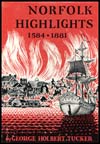Chapter 57
General Pickett's Funeral
General George Edward Pickett, whose division made the famous charge at the Battle of Gettysburg, died on July 30, 1875, in St. Vincent de Paul Hospital at Wood and Church streets in Norfolk.
General Pickett, who was the Virginia agent for the Washingon Life Insurance Co. at the time of his death, had been in Norfolk for several weeks. He was staying at the Atlantic Hotel on Main Street when he was stricken and was moved to the hospital where he could rest more quietly.
According to The Norfolk Virginian of July 31, 1875, General Pickett died at 10:45 p.m. on July 30, after which immediate plans were made to give him an elaborate funeral.
Born in Richmond on January 25, 1825, Pickett graduated from West Point in 1846 and saw service under General Winfield Scott in the Mexican War.
His great day, however, came on July 3, 1863, when he led fifteen thousand men in the daring assault on the Federal lines that is known in history as "the High Water Mark of the Confederacy."
General Pickett's funeral, one of the largest ever held in Norfolk, was described in detail in the August 1, 1875, issue of The Norfolk Virginian.
Although it was a hot day, East Freemason Street was crowded with spectators, while Old Christ Church, at the northwest corner of Freemason and Cumberland streets, where the funeral was held, was jammed to the doors.
The ceremony began when the Norfolk Light Artillery Blues, the Norfolk City Guard, the Grice Commandery of Knights Templars, and the Norfolk Fire Department, led by the Norfolk Post Band, escorted the body from the hospital to the church.
The eighteen pallbearers, headed by General William Mahone, Colonel Walter Herron Taylor, and General Richard Lucien Page, all distinguished Confederates, marched two by two on each side of the hearse.
This was followed by six "stalwart well-dressed colored men" who lifted the coffin from the hearse and bore it into the church under a glittering archway made by the crossed swords of the Knights Templars.
After the burial psalm was sung by the choir, the Reverend O.S. Barten, the rector of Christ Church, read the Episcopal burial service. This was followed by the singing of "Nearer, My God, to Thee," after which the Knights Templars conducted a ritual of their own.
Then the procession re-formed to go to Cedar Grove Cemetery.
Leading it was a platoon of Norfolk policemen, followed by the Norfolk Post Band playing dirges, the Norfolk Guards, and the Norfolk Light Artillery Blues.
Then came the hack containing the clergyman, followed by the Norfolk Fire Department on foot, the hearse, and carriages for the general's relatives and friends.
Pickett was temporarily buried in a vault in Cedar Grove Cemetery as it was not convenient at that time to take his body to Richmond. As no military salute was fired in Cedar Grove, The Virginian hastened to explain:
"In regard to the omission to fire the usual salute over the grave by the infantry, we have been requested to state that according to military etiquettte, such a salute would have barred any future military honors by the State to the illustrious dead. Of course, such honors will be tendered at the proper time."
Pickett's body was subsequently shipped to Richmond, where it was buried in Hollywood Cemetery on October 25, 1875, with full military honors.
Chapter
58
The Russian Invasion
Norfolk Highlights 1584 - 1881

See the "Table of Contents" for links to every chapter in Norfolk Highlights 1584 - 1881 by George Holbert Tucker.
